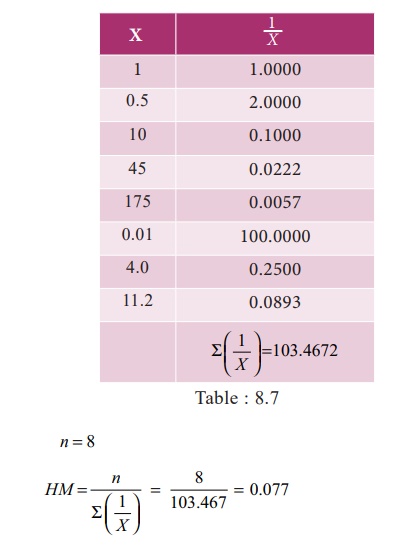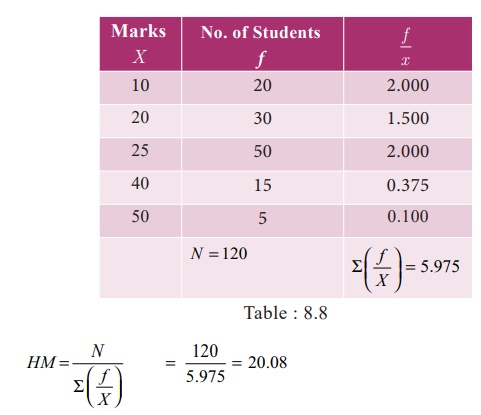Measures of central tendency - Harmonic mean | 11th Business Mathematics and Statistics(EMS) : Chapter 8 : Descriptive statistics and probability
Chapter: 11th Business Mathematics and Statistics(EMS) : Chapter 8 : Descriptive statistics and probability
Harmonic mean
Harmonic mean
Harmonic
mean is defined as the reciprocal of the arithmetic mean of the reciprocal of
the individual observations. It is denoted by HM

When the
number of items is large the computation of harmonic mean in the above manner
becomes tedious. To simplify calculations we obtain reciprocals of the various
items from the tables and apply the following formulae:
(i) In individual observations

where n is number of observations or items or
values
(ii) In discrete frequency distribution

(iii) In continuous frequency
distribution

Where m
is midpoint and N is total frequency
Example 8.9
Calculate the Harmonic Mean of
the following values:
1, 0.5, 10, 45.0, 175.0, 0.01,
4.0, 11.2
Solution:

Example 8.10
From the
following data compute the value of Harmonic Mean .

Solution:
Calculation
of Harmonic Mean

Example 8.11
Calculate
Harmonic Mean for the following data given below

Solution:
Calculation
of Harmonic Mean

Special applications of Harmonic Mean
The
Harmonic Mean is restricted in its field of usefulness. It is useful for
computing the average rate of increase of profits of a concern or average speed
at which a journey has been performed or the average price at which an article
has been sold. The rate usually indicates the relation between two different
types of measuring units that can be expressed reciprocally.
For
example, if a man walked 20km in 5 hours, the rate of his walking speed can be
expressed

where the
units of the first term is a km and the unit of the second term is an hour or
reciprocally,

where the
unit of the first term is an hour and the unit of the second term is a km
Example 8.12
An automobile driver travels from
plain to hill station 100km distance at an average speed of 30km per hour. He
then makes the return trip at average speed of 20km per hour what is his
average speed over the entire distance (200km)?
Solution:
If the
problem is given to a layman he is most likely to compute the arithmetic mean
of two speeds

But this
is not the correct average.
So
harmonic mean would be mean suitable in this situation. Harmonic Mean of 30 and
20 is

NOTE
The Harmonic Mean is a measure of central tendency for data
expressed as rates such as kilometres per hour, kilometres per litre, periods
per semester, tonnes per month etc.,
Related Topics